- Disclaimer and introduction to the review
- The review itself
- Wrap-up
 While this will be a full-fledged review like you’re used to from me, this is also an experiment of sorts. I wanted to cover all different versions of the original Super Mario Bros., but not in three different reviews. For now I’ve decided to cover the main mechanics that are present between all versions, and then talk about each version independently and what makes them better or worse than others. As this is an experiment, it might very well be subject to change in the near future. Without further ado, enjoy my review on all three versions of Super Mario Bros.!
While this will be a full-fledged review like you’re used to from me, this is also an experiment of sorts. I wanted to cover all different versions of the original Super Mario Bros., but not in three different reviews. For now I’ve decided to cover the main mechanics that are present between all versions, and then talk about each version independently and what makes them better or worse than others. As this is an experiment, it might very well be subject to change in the near future. Without further ado, enjoy my review on all three versions of Super Mario Bros.!
Time for a mix! Here’s some music from both the 8-bit and 16-bit versions~
 It was tough to approach this game for a review. I mean, who doesn’t know the original Super Mario Bros.? Everyone and their grandmother has played the game; my review isn’t going to change minds. Still, I did want to make an article on it at the very least so then it actually occurred to me: if I’m going to play Super Mario Bros., what version am I going to play? While this might have been a silly question to me at first as I always go for the best possible port… the opinions on what version is the best are actually quite different. Normally I would say the Super Mario All-Stars version since that is the original game but in 16-bit, but people still seem to have issues with that version. For me, it has actually been a while since I last played the 16-bit version, and I’ve never even once touched the Deluxe edition on the Gameboy Colour. So today, I’m giving you a definitive, factual and totally not personal conclusion on what the best version is!
It was tough to approach this game for a review. I mean, who doesn’t know the original Super Mario Bros.? Everyone and their grandmother has played the game; my review isn’t going to change minds. Still, I did want to make an article on it at the very least so then it actually occurred to me: if I’m going to play Super Mario Bros., what version am I going to play? While this might have been a silly question to me at first as I always go for the best possible port… the opinions on what version is the best are actually quite different. Normally I would say the Super Mario All-Stars version since that is the original game but in 16-bit, but people still seem to have issues with that version. For me, it has actually been a while since I last played the 16-bit version, and I’ve never even once touched the Deluxe edition on the Gameboy Colour. So today, I’m giving you a definitive, factual and totally not personal conclusion on what the best version is!
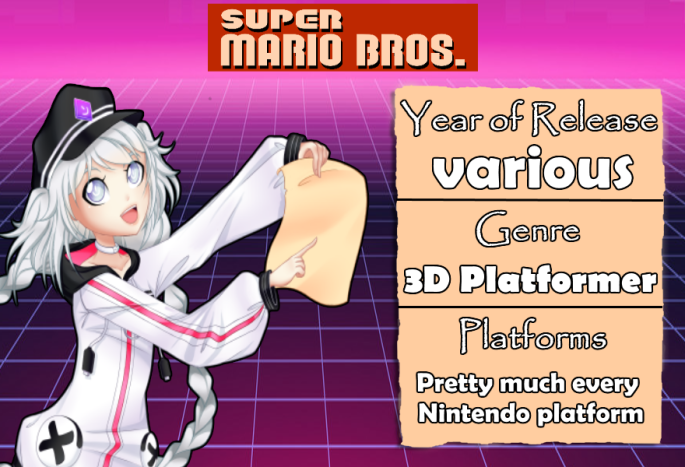
I don’t think I need to tell the story of how influential Super Mario Bros. was to the history of video games. After all, it was one of the defining games that put an end to the video game crash of 1983. This game proved that the home console market could very well work, as it truly felt like an arcade that was part of your own living room. And with that I meant it quite literally, aside from it not taking all of your pennies. You start the game with three lives and when you get a game over, you start all over again from the beginning. This was the typical setup for games in the Arcade, which were all short games but had a higher difficulty to get some money out of you. Super Mario Bros. showed the world how this approach could work on home consoles, while also paving the way for new ideas to differentiate the home console market from the arcades. It was a game with a start, a goal and a finish: get from point A to B in a level, and do so multiple times until you’ve reached the end. It’s a simple concept by today’s standards, but this led to Super Mario Bros.’ advantage. The game could be replayed over- and over again, and since it didn’t require your pennies you could try again as much as you want. And for the explorative gamers which would certainly cause rumours on the school grounds: there are actual warp pipes to get to other worlds without too much effort so you can try harder parts of the game more easily. Not to mention its simple gameplay that could be picked up by literally anyone that got hold of the controller without any prior knowledge, while still not being necessarily an easy game either. You could, of course, use the warp pipes to go straight to world 8, but playing the game as a whole might still prove to be quite the obstacle to overcome. Not to mention world 8 itself which loves throwing hammer bros. at you and almost no power-ups. The games of the 8-bit era were short, and thus did not want you to beat the game quick. And this is basically what Super Mario Bros. as a whole can be described as: a mostly forgiving arcade experience, designed for home consoles.
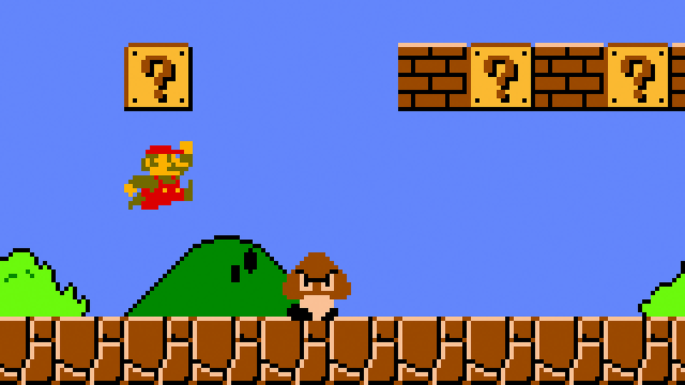
The fundamental classic
Despite being almost 35 years old, the original game has aged quite well. By today’s standards, the inability to move while airborne or backtrack in levels is something I really have to get used to every time I play the game again. But due to the simple design in levels which are mostly just horizontal planes, it is also not too big of an issue. Levels overall are pretty much by-the-numbers; they are plain, and some levels are even repeated. But despite everything that I’m saying here that shows the game’s age, it is also very much noticeable how much elements and mechanics are still being used in later Mario games. Levels with alternate exits, many hidden secrets and even several obstacles are still commonly used in Mario games today, particularly the 2D games. The same can be said about enemies which pretty much all have never left the franchise. You could make the argument that Nintendo is lazy with their 2D Mario games that still rely on the classics, but it also shows how good the fundamental framework is. It’s also pretty accelerating to play while protecting the precious Fire Flower power-up, as it makes the game a whole lot easier to play. One hit without a power-up and you’re instantly dead, and you also can’t shoot fireballs from your fingertips without a power-up. Even that’s something that’s still present in modern games, although a little bit less punishing as you won’t go back to mini Mario immediately after one hit. So yeah, if we look at the game in the current day and age it’s very basic, but I can’t be too hard on it since this was one of the pioneers that have shaped the video game market as we know it today. And it’s still fun to play and that’s all that matters right? …But what version should you play? Boom, nailed that totally-not-forced segue into the next section.
What version should I play???
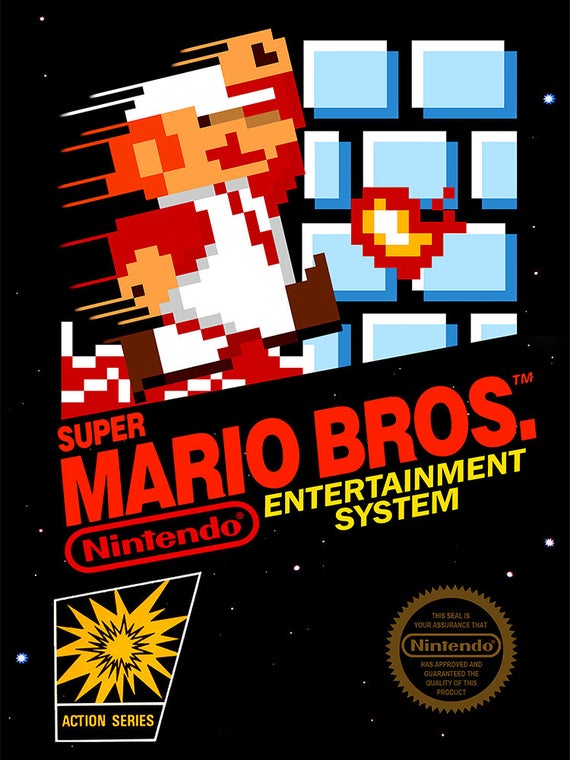
Name: Super Mario Bros.
Year of release: 1985
Original console: NES
Re-releases: Gameboy Advance, Wii, 3ds, Wii U, Switch, NES classic
The original that started it all, and also the most accessible. Unlike the other two versions I’ll be talking about in a bit, this version is readily available on all modern Nintendo consoles including the NES mini. And there is a reason why this version in particular is the most ported aside from it being the original. It still controls very tight, which is the most important part of the game. This is already going to be a slight spoiler for the next few versions, but they are both perfect replicas of the original release which in turn doesn’t make this version worse than the others despite being the oldest. The biggest difference with this release is that there is no option to save the game. Whenever you lose your three lives, you’ll always have to start over again from the first level. The after-completion benefits such as a New Game+ and world select are also gone upon resetting the game. By technicality, if you are playing this on anything other than the original NES and Gameboy Advance, you do have access to save states which negates this version’s biggest weakness compared to the others. A point of frustration I personally have with this version of the game are the maze levels, which do not give any indication of whether you’re going the right path, but there are only two of these levels so it’s not really that big of an issue. Overall, the original version is still a very solid option to choose.
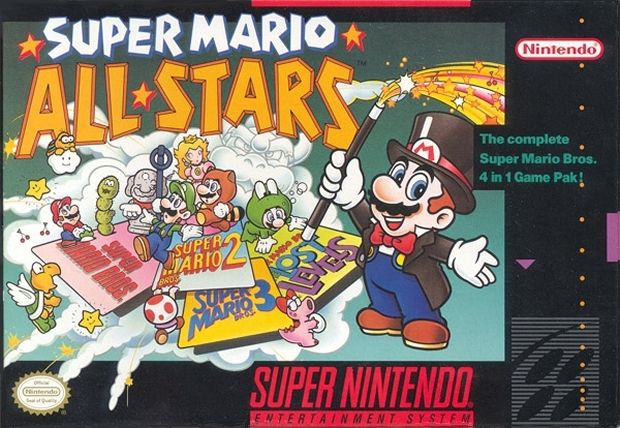
Name: Super Mario All-stars
Year of release: 1993
Original console: SNES
Re-releases: Wii
Out of all the versions, this is surprisingly one of the least ported. It wasn’t even on the SNES Classic, what gives! That means there must be a reason for it right? If you ask me no, not really. The 16-bit version of Super Mario Bros. is pretty much a one-to-one replica of the original release, but with prettier graphics and the ability to save. Every time you get a game over, you don’t start at the very first level of the game but instead at the first level of that world. You also start off with 5 lives instead of 3, which makes it an easier version overall. And hey, there are chimes for the mazes now which… makes them still suck, but just a bit less! I already prefer this version. But the reason why many people don’t really recommend this version over the original that often is that there is a slight change in physics. Breaking blocks feels awkward, and Mario feels a bit more floaty overall. This was only noticeable for me because I’ve played this version right after the original. On its own I didn’t really have much issue with it, and according to experts it’s mostly a visual difference as the coding behind the game is pretty much identical. I’d say the controls in the original release are better, but I don’t think this version is much worse if that makes sense. And I think that can be said for the re-release as a whole: it’s perfectly fine and pretty good-looking overall, but not that much different from the original and therefore neither worse nor better.
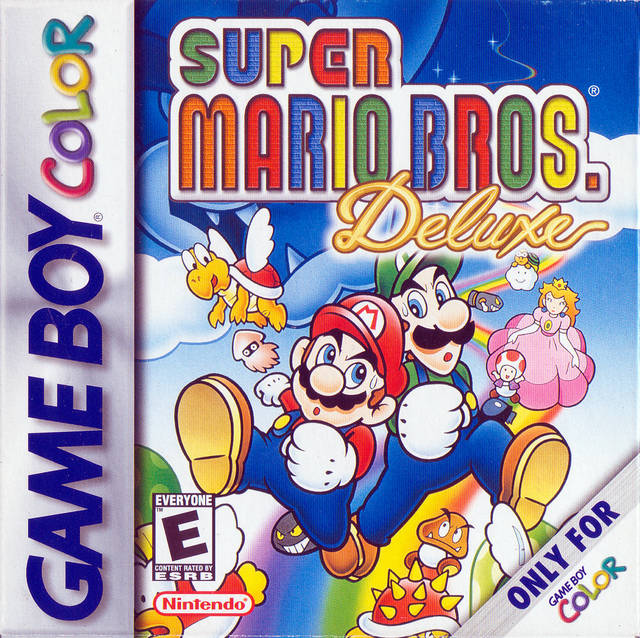
Name: Super Mario Bros. Deluxe
Year of release: 1999
Original console: Gameboy Colour
Re-releases: Nintendo 3DS
I hate that they called the switch port of New Super Mario Bros. U the deluxe version, as it sucks to search this game on youtube- and google now. Out of the three, the Gameboy Colour version of Super Mario Bros. is easily the most controversial and also the one I’m going to spend the most time on here. Let’s start with the amount of content this game has since it actually has quite a good amount! The core game hasn’t changed, but there is now an overworld between levels which I find a fun albeit “unnecessary” addition. Whenever you get a game over in this game though, you don’t start from the beginning of the game or the start of the world, but instead at the same level you died in. Despite being 8-bit, they included the chime for mazes thank god. Outside of the main game however–and this is the best part–is the amount of unlockable content. Every level now has a challenge mode where your objectives are to find five red coins, Yoshi eggs or get a high score. I really love this addition, but you still can’t go left so having collectables in a game like this is not as fun as it sounds. There’s also races against Boo in newly created levels with their own mechanics, a gallery mode with a lot of unlockables and they’ve even recreated the original Super Mario Bros.: The Lost Levels in this port! This all sounds very good, doesn’t it? I agree… if it wasn’t on the Gameboy Colour.
Indeed, the console this game released on is both its biggest strength, and most definitely its biggest weakness. Being able to play the original Super Mario Bros. was a dream come true for many people, but they had to endure a ridiculous amount of screen crunch to do so. There is a reason that whenever you get a game over, you start at the beginning of that level. Even if this game is very much playable as a lot of fans told me they enjoyed this version quite a lot, it doesn’t allow me to play the original game how I want to play it. I have to constantly play at a snail’s pace to not run into off-screen shenanigans, or I have to completely memorize a stage, enemy placements and more. The hammer bros. are the absolute worst to face in this version for example and even though the screen either automatically- or manually goes along with your height, there are still several leaps of faith due to the screen not allowing for much horizontal view. The screen crunch is pretty much the only reason why I don’t like this port as much as the others however, because the controls felt pretty tight to me overall. Let me elaborate that this is not a bad version; just not something for me.
 As to the question that originally led me to create this article; I’m surprised to come to the conclusion that in my opinion, the original 8-bit version is still the best. The 16-bit version is just as good but feels a little bit floaty in comparison, and the Deluxe port has the most content by far but suffers heavily from screen crunch. I do think all versions can be enjoyed regardless but if you have the option to choose between all versions when wanting to play the core game, picking the most accessible version is also the best experience. And while Super Mario Bros. does not offer anything special by today’s standards when it comes to level design and gameplay overall, it is undeniable how much of an impact this game has not only on its own franchise but on gaming as a whole. It still controls good and can easily be picked up by anyone, even by those who have never once played a video game in their life. It truly showed that there was potential in the home console market by giving us an arcade-like experience in our own living room. As always I do give this game a score even though it feels unfair given how much this game has done, but remember that I rate a game on how much I enjoy playing it in the current day. And while I “only” give it a 7.5 out of 10, I still think this is a game that can very much be enjoyed today!
As to the question that originally led me to create this article; I’m surprised to come to the conclusion that in my opinion, the original 8-bit version is still the best. The 16-bit version is just as good but feels a little bit floaty in comparison, and the Deluxe port has the most content by far but suffers heavily from screen crunch. I do think all versions can be enjoyed regardless but if you have the option to choose between all versions when wanting to play the core game, picking the most accessible version is also the best experience. And while Super Mario Bros. does not offer anything special by today’s standards when it comes to level design and gameplay overall, it is undeniable how much of an impact this game has not only on its own franchise but on gaming as a whole. It still controls good and can easily be picked up by anyone, even by those who have never once played a video game in their life. It truly showed that there was potential in the home console market by giving us an arcade-like experience in our own living room. As always I do give this game a score even though it feels unfair given how much this game has done, but remember that I rate a game on how much I enjoy playing it in the current day. And while I “only” give it a 7.5 out of 10, I still think this is a game that can very much be enjoyed today!
Final Score: 7.5/10
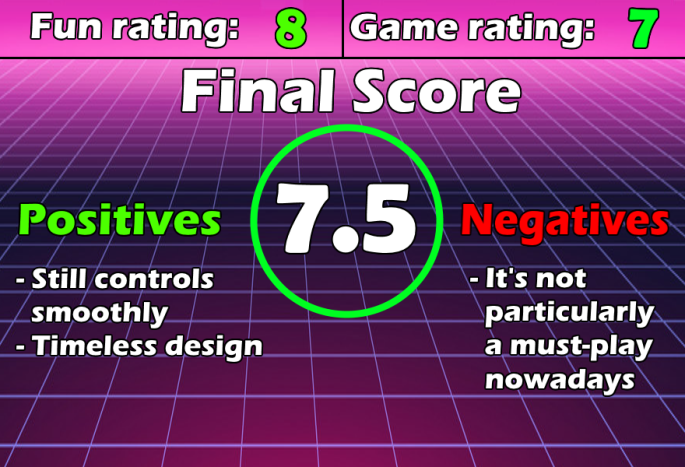
 While I was very careful and–for a lack of better words–“scared” to approach this title for a review, I still very much enjoyed doing so. And hey, maybe I can do something like this more often in the future? I don’t think I’ll go into much detail for the remaining games of the original Mario tetralogy, but that’s something we’ll see in the coming weeks. While it’s not an official marathon, I’m going through all four games at the moment just for my own entertainment since I’ve never officially beaten the second game, and the third only vaguely. So it’s a journey through the history of Mario I guess!
While I was very careful and–for a lack of better words–“scared” to approach this title for a review, I still very much enjoyed doing so. And hey, maybe I can do something like this more often in the future? I don’t think I’ll go into much detail for the remaining games of the original Mario tetralogy, but that’s something we’ll see in the coming weeks. While it’s not an official marathon, I’m going through all four games at the moment just for my own entertainment since I’ve never officially beaten the second game, and the third only vaguely. So it’s a journey through the history of Mario I guess!
 What is your favourite game that you believe has impacted the video game landscape as we know it today? Let me know down below in the comments or reply to me on Twitter/Discord!
What is your favourite game that you believe has impacted the video game landscape as we know it today? Let me know down below in the comments or reply to me on Twitter/Discord!
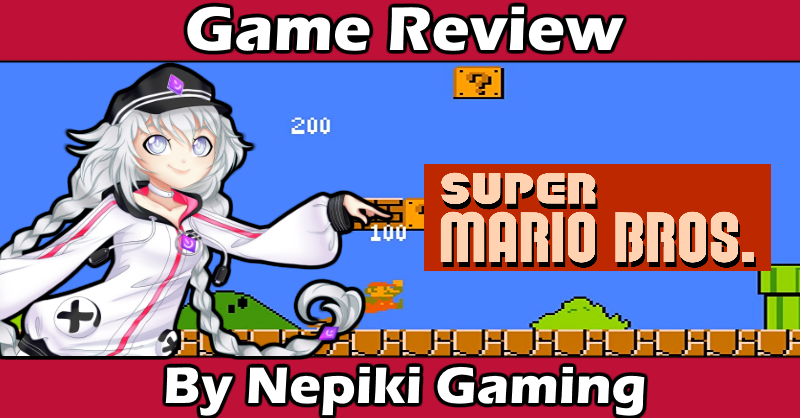






Super Mario Bros. kind of falls in the same category as Pokemon Red and Blue in that while it has been remade several times, the remakes cause the game to lose a lot of its charm. It’s strange because I do not think the same applies to Super Mario Bros. 3, though I think it’s because its predecessor codified the genre to the extent that the original presentation becomes a crucial part of its identity.
LikeLiked by 1 person
I can agree on that, Firered and Leafgreen make some big improvements to the original games but I still have a warm nostalgic feeling for the original that is just not easy to replicate in a remake. The originals will always have that unique magic that will shine even if they show their age.
LikeLiked by 1 person
I definitely agree with you, while I loved having all the NES Mario games in one cartridge in All-Stars, the feel of the games are just a little bit off when compared to the NES counterparts. The controls in Mario 3 don’t feel quite as tight for the All-Stars version.
LikeLiked by 1 person
It’s a slight change, but it makes a world of difference indeed. I particularly disliked how breaking blocks worked since you fell straight down instead of carrying the momentum you already had at the time.
Mario 3 is the one I’m most curious about as that is often the version I hear the most conflicted opinions about. Looking forward to seeing the differences in that version whenever I get to it soon!
LikeLiked by 1 person
To me, there’s something particular about playing the original Mario in its old 8-bit form with the blocky graphics. Playing that Mario/Duck Hunt cartridge at a friend’s place on their massive CRT is one of my oldest memories, so some of that’s probably nostalgia talking. But you’re right that the All-Stars version controls differently as well — I’m not a big fan of that change. The ability to save is great, though.
The influential game I would choose is Mario’s big rival back in the 90s, Sonic. I know a lot of people prefer one to the other, and when it comes to the 3D games there’s no question which is better. But back then, Sonic 1 and especially 2 and 3&K provided a different kind of platformer. I don’t think it was really taking anything away from Mario in that sense; the two have such different play styles that it’s hard to even compare them. I’d also say Sonic 1 is one of those “great for its time” games that hasn’t held up as well as its followups.
LikeLiked by 1 person
I agree! I really appreciate the All-Stars remake despite controlling slightly different, but there is some magic to the original that can’t be replicated that easily.
Very good choice, I can definitely agree on that as another influential game that shaped the gaming market as we know it today! I recently played through the first one again and while it hasn’t aged as good as the other Sonic games of the 16-bit era, I can still see how important this game was at the time it came out.
LikeLiked by 1 person